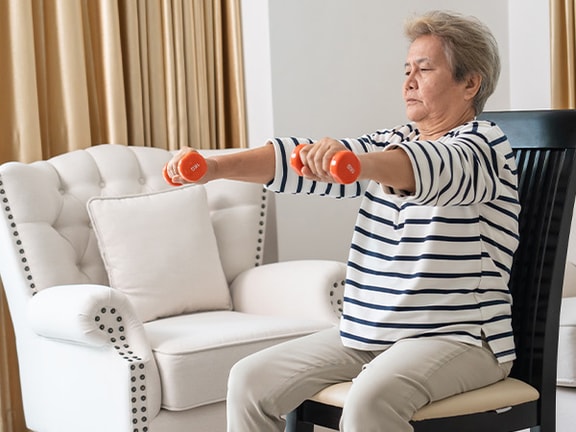Exercise Dosing for Older Adults: Safe and Effective Strategies
Older adults with multiple health conditions face unique challenges when it comes to exercise. This article offers practical strategies to help you design safe, effective programs that improve strength, mobility, and quality of life.
February 10, 2025
11 min. read

Exercise is key to maintaining health and independence in older adults, but prescribing it for patients with multiple comorbidities can feel like navigating a minefield. Conditions like hypertension, diabetes, arthritis, and heart failure can complicate exercise tolerance, limiting the safety and efficacy of physical activity. With tailored strategies, we can confidently design exercise programs that address these challenges while helping our patients achieve meaningful improvements.
As we age, natural declines in physiological function can lead to frailty, characterized by muscle weakness, fatigue, slower walking speed, and unintentional weight loss. This progression increases the risk of adverse outcomes, making physical performance a key indicator of overall health in older adults.1
In this article, we’ll explore practical approaches for managing exercise dosing in geriatric patients with complex health profiles, focusing on how to balance safety with progression while promoting long-term adherence and success.
How comorbidities impact exercise capacity
Comorbidities significantly shape a patient’s ability to engage in physical activity, influencing both tolerance and safety. Chronic conditions such as heart failure, chronic obstructive pulmonary disease (COPD), and arthritis amplify risks like fatigue, dyspnea, and vascular complications. For example:
A person with arthritis and hypertension may experience joint pain that discourages movement and fluctuating blood pressure during exercise, limiting their engagement.
Individuals with insulin-dependent diabetes face a heightened risk of hypoglycemia, requiring vigilant monitoring before, during, and after activity.
A person recovering from a hip fracture with concurrent COPD might struggle with pain and reduced mobility, compounded by dyspnea and carbon dioxide retention during exertion.
Patients with heart failure often face reduced cardiac output, leading to early fatigue and decreased oxygen delivery to working muscles, making even moderate activity challenging.
Recognizing these challenges allows us to develop tailored exercise plans that prioritize patient safety while leveraging the benefits of physical activity. By understanding the interplay of conditions and their cumulative impact, we can create programs that address the limitations and strengths of each patient, fostering gradual and meaningful improvements.
Core principles of exercise dosing
Start low and progress gradually
Monitor and adjust in real-time
Focus on functional goals
Use variety to enhance engagement
These four foundational principles can help you create effective exercise programs prioritizing safety and meaningful progress. They allow you to tailor interventions to the unique needs of each individual you serve, empowering them to achieve their goals. Let’s take a closer look at how you can apply these strategies in your practice:
1. Start low, progress gradually
Begin with low-intensity activities, especially for patients who are deconditioned or managing unstable conditions. A “lowest effective dose” approach reduces risk while building confidence and tolerance. Try the following:
Initiate aerobic activity at 40 to 50 percent of heart rate reserve or use a perceived exertion rating of 9 to 11 on the Borg scale to gauge effort.
For resistance training, begin with one set of exercises at 40 to 50 percent of their one-repetition maximum (1RM), focusing on controlled and safe movements.
By starting small and increasing intensity as your patients progress, you’ll help them build strength and endurance without overwhelming them physically or emotionally.
2. Monitor and adjust in real-time
Frequent monitoring helps you ensure safety and make necessary adjustments on the fly.
For people with hypertension, skip exercise sessions if their resting systolic pressure exceeds 180 mmHg or their diastolic pressure is over 110 mmHg.
For individuals with diabetes, check blood glucose before and after sessions to maintain safe levels (e.g., 150 to 250 mg/dL). Be prepared to intervene using the 15/15 rule (consume 15 g of carbohydrates, wait 15 minutes, and recheck glucose) if hypoglycemia occurs.
Stay attuned to any signs of fatigue, dizziness, or discomfort, and adjust intensity or duration as needed. This dynamic monitoring ensures you tailor the session to the person’s real-time capacity.
3. Focus on functional goals
Prescribing exercises that directly enhance activities of daily living (ADLs) can make a tangible difference in your patients’ daily lives. Consider incorporating:
Chair stands to improve lower-body strength, aiding in transfers from seated to standing.
Light resistance exercises to build grip strength, helping with tasks like opening jars or carrying groceries.
Step-ups or stair climbing to improve mobility and confidence when navigating uneven surfaces or stairs.
Functional exercises like these do more than build strength—they provide a direct pathway to independence and improve your patients’ ability to engage in meaningful activities that enhance their quality of life.
4. Use variety to enhance engagement
Maintaining adherence to an exercise program can be challenging for many patients. Incorporating a variety of activities can keep programs interesting and enjoyable, making it easier for your patients to stay committed.
Activities such as aquatic therapy and rhythmic movements like dancing—or even gardening—can make exercise feel less like a chore and more like an enjoyable part of life. Tailoring exercises to your patients' preferences not only improves adherence but also fosters a sense of accomplishment, further motivating them to remain active.
Practical strategies for specific comorbidities
Comorbidities present unique challenges to exercise prescription, but they can be managed effectively with thoughtful planning and individualized care. Below, we’ll discuss common conditions and provide strategies that you can implement to help your patients safely and confidently engage in physical activity.
Hypertension
Hypertension is one of the most common comorbidities encountered in geriatric patients, often coexisting with other cardiovascular risk factors. Based on data from the National Health and Nutrition Examination Survey, 70 percent of adults over 65 years old have hypertension.2 Its effects on exercise tolerance, such as increased cardiac workload, make monitoring essential.
Still, regular exercise plays a critical role in managing hypertension. Research indicates that exercise significantly reduces both systolic and diastolic blood pressure, reinforcing its role as a key component of treatment for hypertensive older adults.3 By incorporating aerobic and resistance training, clinicians can help patients improve cardiovascular health while maintaining safety.
Aerobic exercise: Low- to moderate-intensity activities like walking or swimming performed for 30 minutes a day, five days a week, are ideal. Monitor blood pressure before, during, and after exercise to ensure safety and adjust intensity if needed.
Resistance training: Start with 40 to 50 percent of 1RM and progress gradually to moderate intensity. Avoid Valsalva maneuvers, which can spike blood pressure, and emphasize steady, controlled movements. With proper progression, individuals with disease risk factors and known diseases can safely tolerate high-intensity resistance training to achieve optimal strength gains.
Diabetes
Diabetes, especially in insulin-dependent patients, demands meticulous exercise planning. In the United States, adults aged 65 and older represent over 25 percent of the population with diabetes.4 With this increasing prevalence, incorporating exercise into treatment plans for older adults with diabetes is more important than ever for improving glucose control, maintaining mobility, and reducing complications.
Glucose monitoring: Before exercise, ensure glucose levels are within safe ranges. Use the 15/15 rule if levels are below 150 mg/dL.
Exercise timing: Plan sessions away from insulin peaks to reduce the risk of hypoglycemia. Encourage patients to carry a quick source of carbohydrates during activity.
Osteoarthritis
One in three people over age 65 are living with osteoarthritis (OA)5, a leading cause of pain and reduced mobility in older adults that often discourages physical activity. OA often coexists with other chronic conditions and can worsen health outcomes, making effective management essential.
Tailored exercises can reduce stiffness, improve joint health, and enhance overall function. Starting with low-impact activities helps build confidence and alleviate discomfort while promoting long-term adherence.
Low-impact aerobics: Options like aquatic therapy or stationary cycling reduce joint strain while promoting mobility.
Joint protection: Incorporate resistance exercises targeting major muscle groups with light weights and high repetitions (10 to 15 reps). These exercises enhance strength and stability without exacerbating joint pain.
Depression
Depression can significantly reduce motivation, energy levels, and overall engagement in physical activity. It is one of the most common mental health conditions in older adults, yet it often goes undiagnosed—studies estimate that nearly 50 percent of cases in the elderly population are unrecognized.6
Despite its prevalence, depression is often treatable, and exercise is a powerful tool for improving mood and mental health, particularly when integrated into daily routines. Encouraging enjoyable and social activities can help your patients maintain consistency and build a positive relationship with movement.
Frequency: Promote daily or near-daily exercise to maximize its mood-enhancing effects. Short, frequent sessions work best for maintaining adherence.
Engagement: Include group activities or rhythmic exercises like dancing to address feelings of isolation and improve overall enjoyment.
Encouraging patient confidence
Patient education is one of the most powerful tools you have to build confidence and trust in your patients. For individuals managing complex comorbidities, fear of exacerbating their condition or experiencing discomfort can be a significant barrier to starting and maintaining an exercise program. By addressing these concerns directly, you can help them move forward with greater assurance.
1. Educating patients on what to expect
Start by educating your patients about what to expect during exercise. For example, explain that mild joint discomfort or fatigue is normal and manageable, emphasizing that it is a sign of their body adapting and growing stronger. Providing this information upfront can demystify the process, ease patient anxiety, and empower them to persist through initial challenges.
2. Fostering trust through reassurance and monitoring
Reassurance paired with close monitoring is key. Regularly check in with patients about how they feel during and after exercise sessions. Adjust the intensity or type of activity as needed to maintain safety while fostering progress. This collaborative approach helps patients feel supported and in control of their journey.
3. Elevating care with continuing education
As a physical therapist, continuing education can enhance your ability to guide patients with confidence. Staying current with evidence-based practices allows you to refine your approach, address barriers more effectively, and inspire greater trust in your expertise. By expanding your knowledge through physical therapy continuing education, you’re better equipped to deliver care that empowers patients and helps them achieve meaningful results.
Confidence is built over time, but with education, support, and thoughtful program design, you can guide your patients toward improved physical health and renewed self-belief in their capabilities.
Transforming lives through thoughtful care
Designing effective exercise programs for older adults with complex comorbidities requires a balance of clinical expertise, creativity, and empathy. By starting with foundational principles like gradual progression, real-time monitoring, and individualized goals, you can create programs prioritizing safety and building long-term success. Remember, every slight improvement in strength, mobility, or confidence translates into meaningful gains in independence and quality of life for your patients.
Your role as a physical therapist extends beyond prescribing exercises—it's about empowering patients to overcome barriers, embrace movement, and reclaim their health. Stay committed to refining your skills and expanding your knowledge through evidence-based strategies and continuing education.
To learn more about designing safe, effective exercise programs for patients with complex health needs, watch my course, Exercise Dosing for Geriatric Patients with Multiple Comorbidities, for practical tools, clinical insights, and actionable strategies to enhance patient outcomes.
References
Li, P. S., Hsieh, C. J., Tallutondok, E. B., & Peng, H. J. (2022). The Dose-Response Efficacy of Physical Training on Frailty Status and Physical Performance in Community-Dwelling Elderly: A Systematic Review and Meta-Analysis of Randomized Controlled Trials. Healthcare (Basel, Switzerland), 10(3), 586. https://doi.org/10.3390/healthcare10030586
Mozaffarian, D., Benjamin, E. J., Go, A. S., Arnett, D. K., Blaha, M. J., Cushman, M., de Ferranti, S., Després, J. P., Fullerton, H. J., Howard, V. J., Huffman, M. D., Judd, S. E., Kissela, B. M., Lackland, D. T., Lichtman, J. H., Lisabeth, L. D., Liu, S., Mackey, R. H., Matchar, D. B., McGuire, D. K., … American Heart Association Statistics Committee and Stroke Statistics Subcommittee (2015). Heart disease and stroke statistics--2015 update: a report from the American Heart Association. Circulation, 131(4), e29–e322. https://doi.org/10.1161/CIR.0000000000000152
Kazeminia, M., Daneshkhah, A., Jalali, R., Vaisi-Raygani, A., Salari, N., & Mohammadi, M. (2020). The Effect of Exercise on the Older Adult's Blood Pressure Suffering Hypertension: Systematic Review and Meta-Analysis on Clinical Trial Studies. International journal of hypertension, 2020, 2786120. https://doi.org/10.1155/2020/2786120
Erika Leung, Supakanya Wongrakpanich, Medha N. Munshi; Diabetes Management in the Elderly. Diabetes Spectr 1 August 2018; 31 (3): 245–253. https://doi.org/10.2337/ds18-0033
Hawker, G. A., & King, L. K. (2022). The Burden of Osteoarthritis in Older Adults. Clinics in geriatric medicine, 38(2), 181–192. https://doi.org/10.1016/j.cger.2021.11.005
Zenebe, Y., Akele, B., W/Selassie, M., & Necho, M. (2021). Prevalence and determinants of depression among old age: a systematic review and meta-analysis. Annals of general psychiatry, 20(1), 55. https://doi.org/10.1186/s12991-021-00375-x
Below, watch Ray VanWye discuss what is a comorbidity this brief clip from his Medbridge course "Exercise Dosing for Geriatric Patients with Multiple Comorbidities."






